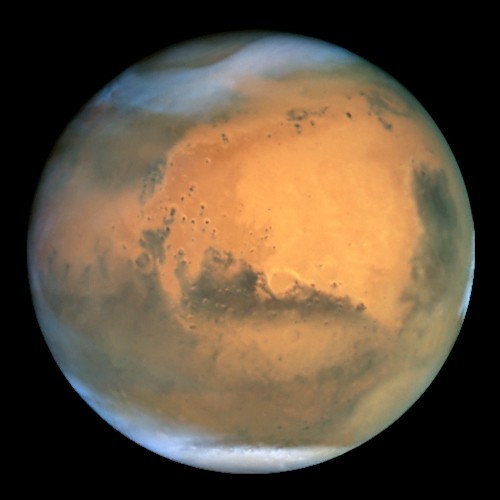 |
Figure 14 Mars (http://en.wikipedia.org/wiki/File:Mars_Hubble.jpg) |
Conundrum 8: Mars' axial tilt
Where did Mars get its axial tilt?If the Earth got its axial tilt from an impact event, then where did Mars get its from? If we assume that we are correct about the genesis of the Moon, then we also need to believe that Mars was impacted as Earth was. It seems very unlikely that Mars would be impacted with just the right size of planetoid and at just the right angle (and velocity) to create an almost identical axial tilt to the Earth (and since no large moon was created, the mechanics would have had to be very different).
There are other unique oddities about Mars. The biggest of which is the question of its atmosphere. According to CSB, Mars had an atmosphere very similar to Earth's in the beginning (4 Gya) - and it lost (most of) it. Mars' gravity was not strong enough to hold onto its own atmosphere. This begs the question, if Mars' gravity was not strong enough to hold an atmosphere, then how did it attract an atmosphere in the first place?
Conundrum 9: Mars' (anomalously) thick atmosphere
Where did Mars get its atmosphere from? And while we're at it, where did Mars get its water from?According to CSB, Theia (the impactor on the Earth) was "Mars sized". That's an interesting conjecture. Basically anything bigger would have destroyed the Earth, and anything smaller would not have been big enough to create the Moon. So "Mars sized" was 'just right" (The Goldilocks Theory?).
What else is "Mars sized" in relation to the Earth? If you removed the inner and outer core of the Earth (3488 miles in diameter), there would be enough room to fit Mars (3396 miles in diameter) inside (A perfect [97%] fit! Only 92 miles to spare). Hmm, now that we have Mars inside of Earth (experimentally), how does it compare to the Earth's mantle (rock) around it?
Mars' rotation is quite close to Earth's (a Mars day (sol) is 24 hours and 39 minutes). Mars' mean density (~4.0 gm/cm3) is about the same as the Earth's mantle. Mars has significant amounts of Olivine - the most prevalent mineral in the Earth's mantle. Mars also has loads of iron - which we have here in abundance.
I think you would be hard-pressed to see any differences between Mars and the Earth's mantle. They look the same (same color?). They are composed of the same minerals and elements. They have the same density. They have the same rotation and tilt. The hole in the mantle (minus the cores) is the same size as Mars. I would say that when you compare the two, you would say EYE-den-ti-cal. The reason Mars is similar to the Earth is because Mars is the Earth (or part of it).
Proposal 4
The impact of Theia on the Earth created Mars (and the Moon).There is a theory today that says that Earth had water when Theia impacted it. Some Moon dust (brought back by astronauts) that is in the shape of spheres, seemed to have formed from water. If the Earth had water at the time of the Theia impact, then some of that water was captured by Mars when it was created.
In order to "shoot" Mars into the orbit it has today, the Theia impact must have been a doozy. It really would take the equivalent of a baseball bat hitting a homer (instead of a bunt). This means that Theia had a tremendous amount of energy (momentum) in order to do this. It would be very "tricky" to have an impact of this force, without turning the Earth into an asteroid belt! What the heck could have done this?
No comments:
Post a Comment